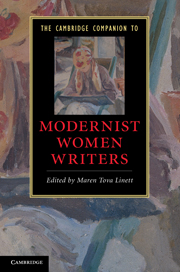Book contents
- Frontmatter
- Modernist women’s literature: an introduction
- 1 Transforming the novel
- 2 Modernist women poets and the problem of form
- 3 Women’s modernism and performance
- 4 Magazines, presses, and salons in women’s modernism
- 5 Gender in women’s modernism
- 6 Black women’s modernist literature
- 7 Race and ethnicity in white women’s modernist literature
- 8 Geomodernism, postcoloniality, and women’s writing
- 9 Women modernists and visual culture
- 10 Modernism and trauma
- 11 Political activism and women’s modernism
- 12 Religion and the occult in women’s modernism
- Guide to further reading
- Index
11 - Political activism and women’s modernism
Published online by Cambridge University Press: 28 November 2010
- Frontmatter
- Modernist women’s literature: an introduction
- 1 Transforming the novel
- 2 Modernist women poets and the problem of form
- 3 Women’s modernism and performance
- 4 Magazines, presses, and salons in women’s modernism
- 5 Gender in women’s modernism
- 6 Black women’s modernist literature
- 7 Race and ethnicity in white women’s modernist literature
- 8 Geomodernism, postcoloniality, and women’s writing
- 9 Women modernists and visual culture
- 10 Modernism and trauma
- 11 Political activism and women’s modernism
- 12 Religion and the occult in women’s modernism
- Guide to further reading
- Index
Summary
Within one tradition of Western thought, politics and the arts have been categorized as distinct and separate entities. So when aesthetics is under discussion, political concern is often dismissed as dogmatic, ephemeral, or partial, and when politics is of chief interest, aesthetics is swept aside as immaterial, insubstantial, or obscure. The way literature has been defined and categorized in the West has been shaped by such binary formulations. Consequently, there has been a long and deep conflict between the model that regards art as representing eternal ideas that are antecedent to human thinking and the model that understands art as a form of concrete communication or social interaction that is historically situated. The two models are predicated on radically different kinds of relationship between the writer and the world: the former requires the writer to have an aesthetic knowledge of the world that comes from detachment whereas the latter demands the writer to possess and to actively use cognitive knowledge. Such categorical division based on mutual exclusivity has been rejected by the Frankfurt school of Marxist critics between the 1930s and the 1950s, either by claiming that every literary practice mediates a socio-political content, or conversely, by seeing political discourse as a form of literature. This alternative view, that literature and politics are inevitably bound together, mutually entailed and so inseparable, has become almost as familiar as the traditional view in the postmodern era.
- Type
- Chapter
- Information
- The Cambridge Companion to Modernist Women Writers , pp. 172 - 186Publisher: Cambridge University PressPrint publication year: 2010
- 6
- Cited by

